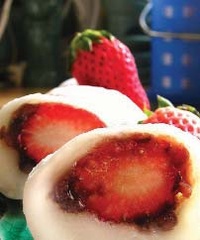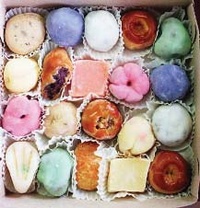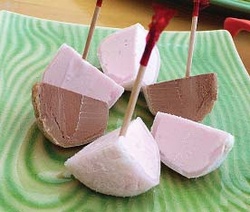* * *
Editor’s note:
One of the traditions that many immigrants keep that ties them to their home country is the food they prepare. Some traditions like mochitsuki and eating mochi bring fond memories to many Nikkei around the world. There are mochitsuki events posted on Discover Nikkei, including Chicago, USA and British Columbia, Canada. This article talks about the origins, traditions and forms of mochi and mochitsuki.
* * *
You are in Japan, mid-last century, December 28; hence, you certainly can’t miss the rhythmic pettan-pettan accompanied by a grunt, a swish, a smash, and some curious exhalations incessantly occurring every two or three seconds, and running through this early winter day. As if stricken on the cymbals in a gigantic orchestra, these happy notes enliven the symphonic poem that is Oshogatsu, the Japanese New Year.
The street rumpus goes on until nightfall when the strange folks with the heavy mallets, awesome mortars and gigantic black cauldrons, the mochi-making crews return home, all pooped out, perhaps to pound just a little more for their own family. But all that is purely another chapter of History, since now, making mochi by hands—yes, plural, stubbornly survives, mainly as a tourist attraction, in some temples and other public places; and in faraway villages. I’ll tell you more about this, later.
Traditional mochi-making needs the hands of a small army. The kitchen troop cooks the glutinous rice, mochi gomé (餅米), left to soak overnight. It also prepares the ‘dressings,’ the mame, kinako, nori, anko, natto and the ozoni.1 When ready, someone brings the hot, cooked rice to the usu, a mortar carved from the trunk of a good size tree or chiseled out of a boulder.2 One man armed with a kine, gigantic wooden mallet, stands near the rim of the usu. A woman with a pail of water nearby kneels on the opposite side. She begins moistening, slapping and shaping the rice mass. And the traditional ritual of mochitsuki (餅搗き)3 begins, in a memorable rhythm:
Oomph!—mallet up, one–two; mallet down;
hit—Hito-usa! (one mortar)…
Wet-slap-shape…
Oomph!—up, one–two; down;
hit—Ni usa! (two mortars)…
Wet-slap-shape, etc.
Experienced mochi pounders use their hips to add momentum to each hit, and skillfully relax their arms so that the kine may nose-dive right into the center of the rice-mass and avoid the helper’s knuckles. Fifty textbook hits are possible if the pair enters tariki: that is, become muscle-rice mass-water-mallet-mortar-rhythm-time…and each other. Each pounded grain represents a stretched out soul enmeshed in a communal exercise of purification. That is the spirit of mochi—what makes it come out always perfect.
Big, round, immaculately white, mochi is the perfect symbol of purity and off spiritual union with tradition and community in the now.
O-shogatsu without mochi is unimaginable. The first mochi is fashioned into the kagami—mirror-shaped form: a small round cake sitting atop a larger round. The first ‘mirror,’ decorated according to the local tradition,4 is set on the family altar; another is placed near the kadomatsu, the New Year’s arrangement; and one more may be set near the home’s entrance. Ultimately, mochi is to be communally shared. If you want your life and your love relations to remain glued for one more year, you must eat mochi on New Year’s Eve.
It wasn’t always that way. In the first or second century BC, Korea already had developed some sort of rice cake; so the idea could have migrated to Japan. But mochi, its protocol mochitsuki and its lore are unique to our culture.
Perhaps the first mochitsuki occurred sometime after the kami5 descended to Earth, when rice cultivation began in Yamato in the Yayoi period (300BC–300AD). If you accept the Nihongi as truth, the practice may have started much, much earlier.
In the beginning, red rice, the ancestor of o-kome was the ingredient for mochi. But that food was for religious offerings, and, at best, eaten exclusively by the Emperor and the nobles as a sacred dish. It was also an omen of fortune. In the Fifth Century AD, in Fushimi, near Kyoto, we find Hata no Irogu (秦伊呂具), a chieftain of Korean descent, head of the Hata clan using mochi to test his skill at archery. The arrow he chooses hits the mochi, which becomes a white pheasant that flies up Mount Mitsugamine, lands there, and then becomes rice stalks again.6 Hata-kun ended up having to build a temple to Uka-no-mitama-no-kami, the August Spirit of Food.7 The Grand Temple Fushimi Inari-taisha is still there.
See? You don’t mess around either with sacred symbols, or with Mama’s traditional
Mottai nai! (We don’t waste!)
During Prince Shotoku’s regency, (573–621) people went so wild about mochi that he had to publish an edict to stop the extravagance. To drive away evil spirits, Emperor Shomu (701–756) had High Priest Gyoki build the Mizuma-dera8. As a charm, Gyoki used sixteen children to pound mochi with one-thousand pestles.9
By the Heian period, (794–1192) mochi was frequently used as ‘Food for the Gods,’ in Shinto rituals by the aristocracy. It was also the talisman for happy and unbroken marriages. On the morning after the third nuptial night, when marriage was formalized, the couple found beautiful pieces of mochi placed behind their headrests. Lady Murasaki Shikibu details this custom in Book Nine of her delightful Tale of Genji.10
During New Year, warriors celebrated the kagami biraki, mirror opening ceremony,11 by proffering mochi to their armor; the ladies presented it to their mirrors. Many contemporary Martial Arts dojo-training halls hold a ritual derived from that tradition on the second Sunday in January. That is known as Hatsu geiko, first meeting of the new teaching cycle, when the students renew their dedication to training, and share pieces of mochi.12
In the Edo period, (1603–1868) mochi became available to the masses. From then on, Japanese ingenuity created byproducts such as kusa or yomogi mochi (Artemisia mochi); kinako mochi with sweetened bean powder; inoko (pig) mochi, with roasted sesame seeds, persimmon or chestnuts; sweet potato13 mochi daifuku, filled with sweetened azuki beans; hishi-mochi for Girls’ Day, kashiwa for Boys’ Day; all kinds of wagashi and mochigashi; and of course, dango.
Now, we find, coconut, pineapple, mango, green tea, peanut butter, almond, sesame seed, coffee, and chocolate mochi. And, to the chagrin of the traditionalist, mochi with cheese and nori; fried bacon mochi; mochi topped with mozzarella and baked, and mochi ice cream.
However, particularly on the coldest days of the year, nothing compares to the simple crunchy, roasted mochi, wrapped in a sheet of nori, and enhanced with a dash of shoyu. Eating mochi is not an exclusive pastime of O-shogatsu. Tradition has it that in October, to celebrate the young, courageous Wild Boar14, the family must prepare inoko mochi and set it on the home altar. After offering it to the Deity, the folks share it. If one eats mochi pounded on the day, month and Hour of the Boar (9-11pm), one will be free from all disease. Women also honored the day by offering mochi to their patron saints, Ojizo-sama, especially, and by praying for many children, as courageous as the young boar.
By the way, you must reassure the kids that though traditions keep being discarded, Usagi-san, the rabbit and lonely inhabitant of the moon finds no reason to change his ways; so he’ll never stop pounding his mortar happily on full moon nights.
Alas! Since about 1967, a new technology: “the mochi-making machine” began threatening the old rituals. Initially, farmers and traditionalists resented the intrusion, but when they found how easy the new mochi machines work, they began adopting them.
But wait, it is even worse. Several companies now pack mochigome powder which you put in a ‘machine,’ add water, whirl, and in a few seconds have instant mochi… (‘soulless mochi’ many retort.)
More information in:
- Donald Richie’s A Taste of Japan.15 A prolific writer, Mr. Richie has spent over 50 years in Japan, where he’s got many awards for his work.
- Yanagita Kunio’s Guide to Japanese Tales16 which has a number of lovely stories about mochi.
- Kodansha’s JAPAN –An Illustrated Encyclopedia.
- The East magazine; December 1982; story: “Why is the Mallet so Heavy?” a very detailed piece on mochi.
- You’ll also find at least 2,130,000 entries on mochi in Google, through your computer.
Kotoshi mo, dozo yoroshiku!
Notes:
1. The boiled beans; powdered soya; seaweed; sweet been paste; fermented beans, and the New Year’s “stew.
2. They are now cast on concrete, too.
3. From mochi and tsukuru: to make mochi.
4. There are too many styles to decorate the “mirror;” listing all would make this piece too lengthy. But the most common decoration is a ‘daidai’ or a ‘tangerine orange placed on the top piece of the cake.
5. The gods in the Japanese Olympus.
6. Yamashiro no kuni no fudoki (Report on Yamashiro country). Encyclopedia of Shinto-Kokugakuin University. Japan. http://www.kokugakuin.ac.jp/index_e.html The Hata clan were also early sericulture teachers. See also: Karen A. Smyer’s The Fox and The Jewel. Honolulu: Univ. of Hawaii; 1999
7. The Kojiki - (Trnsl. Basil Hall Chamberlain). Tokyo: Tuttle, 1981.
8. Near Osaka, Japan.
9. The legend is known as Senbon Mochitsuki to Risho no Zeniiri Mochimaki. Now, young people pound mochi to the Senbon (a thousand) song, and share it with those visiting the temple on January 2 and 3.
10. See Royall Tyler’s translation: Chap. 9 Heart to Heart; pp. 186-90 & footnotes. New York; Penguin Books, 2001.
11. Actually, mochi cake cutting.
12. The ceremony commemorates the day when Amaterasu was tricked out of hiding. Sharing mochi is sharing the spirit of the “toshigami” the New Year. Zen Buddhists may interpret the act as breaking the images of the past and starting anew.
13. Some sources assure that the first Japanese mochi was made with sweet potato, not rice.
14. The Wild Boar is one of the symbols in the Japanese Calendar.
15. Tokyo: Kodansha.1985.
16. Edited and translated by Fanny Hagin Mayer. Bloomington: Indiana University Press; 1986.
*This article was originally published in The Newslette: A Publication of the East San Gabriel Valley Japanese Community Center (December 2009, Issue 12).
© 2009 Edward Moreno








